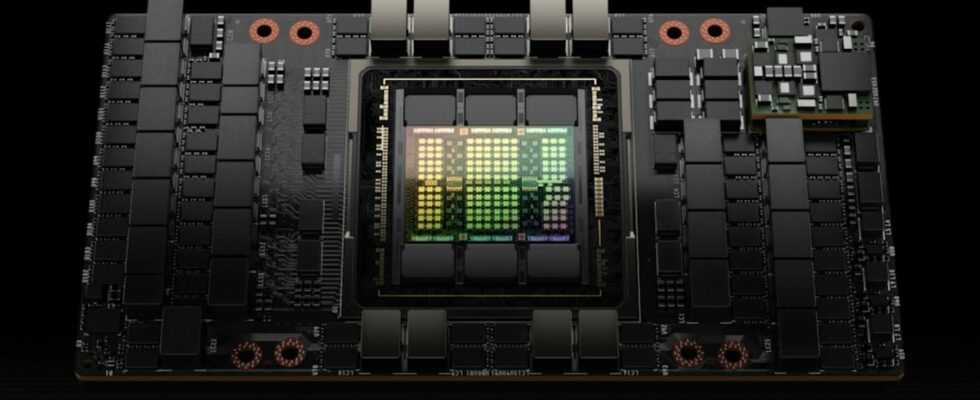4
Nvidia took advantage of the GTC to unveil Hopper, its new GPU architecture designed for the professional sector eager for hardware acceleration. All materialized by the H100, a huge GPU with 80 billion transistors engraved in 4 nm.
For the mainstream, Nvidia is first and foremost a premier graphics card chipmaker, with GeForce series reigning supreme in the market for over a decade. But driven by its leader Jensen Huang, the company has always seen much further than the gamer market and very quickly positioned itself as a major player in hardware acceleration. A field where the demand is growing, even exponential, as the resource requirements are enormous on subjects such as artificial intelligence and the management of models (climate, road, etc.) among others.
For this particular sector, Nvidia has historically always had two different approaches. The first consisted in adapting its graphic architectures in two variants, one for the general public, the other professional — as in the case of Ampère —; the second sought to create two distinct architectures, each targeting a specific market, as was the case with Volta, which was specifically developed for the field of acceleration.
Hopper subscribes to this second approach. The architecture was designed for the domain of acceleration, so as to meet the expectations of AI or even the omniverse. And the least we can say is that two years after the GA100 chip (Ampère architecture), Nvidia is coming up with a fairly impressive H100 chip on paper. Comprising 80 billion transistors spread over an area of 814 mm², it stands out quite clearly from its predecessor, which was “limited” to 54.2 billion transistors over 828 mm². Figures that are not misleading, Nvidia having abandoned 7 nm engraving in favor of the 4 nm offered by TSMC (node N4). The chip also consumes a maximum of 700 W, much more than the 500 W maximum of the previous generation.
Embedding a PCIe 5.0 interface, the chip is surrounded by a maximum of 80 GB of dedicated HBM3 type memory – enough to offer a bandwidth of 3 TB / s. The specific calculation units – which Nvidia calls accelerators – have been revised, with a fourth generation of Tensor Core dedicated to AI in particular, and which are announced as six times faster than those of the GA100 chip. The number of CUDA Cores type calculation units explodes, going from 6912 to 16,896. This gives rise to raw performance three times higher than on the old generation accelerator, and this, it should be remembered , in just two years.
Nvidia has also imagined a new acceleration engine called Transformer Engine. This is intended to accelerate the processing of models linked to artificial intelligence around real-time translation, query interpretation, image analysis or even in the field of health and climate. Neural training that used to take days can now be done in just hours. A feat that will interest its world, in particular Google, whose BERT algorithm uses this type of engine to better understand user requests and respond more and more precisely to these questions. As an example, Nvidia indicated that a job that took 7 days on 8000 GPUs would now only take 20 hours with Hopper chips.
This new GPU will be offered to Nvidia partners starting in the third quarter. It can be purchased individually (PCIe format) but also in the form of DGX racks integrating 8 modules or SuperPOD cabinets in which there are 32 modules. A maximum of 256 modules can be interconnected using an NVLink switch capable of establishing communication at 70.4 TB/s between the modules. Finally, supercomputers are already on the program, in particular Nvidia’s Eos unit — a supercomputer that the company will use itself and which it will offer to its partners — which will include 576 DGX racks or 4608 GPUs. The Eos will offer a computing power of 275 petaFLOPS in FP64, which will position it as the second supercomputer in the world, behind Fugaku (442 petaFLOPS). It now remains to wait for announcements from Nvidia in the field of the general public: the firm should most likely announce the succession of Ampère in the coming months.

